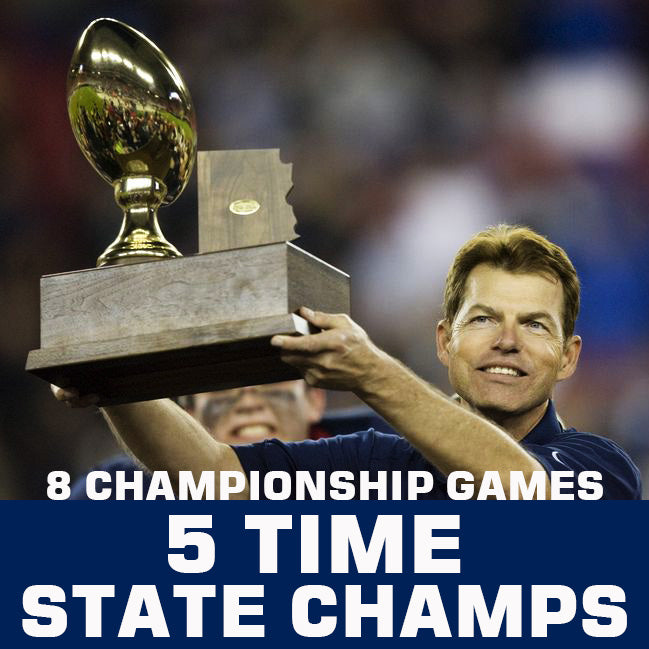From Ohio to Arizona: A BFS Success Story

Originally Published 2017
As the Centennial Coyotes football team celebrated its 5th state championship in November 2015, many people could not remember a time that Centennial was not a football powerhouse. Centennial, led by Coach Richard Taylor, had just competed in its 8th state championship game since 2005. However, this run of success seemed like a dream in the early years of the program.
Centennial High School is in Peoria, a suburb of Phoenix. It opened in the 1990s surrounded by well-established football programs, as thus it was a struggle to get the program off to a successful start. But Centennial did have one advantage. The Coyotes had used the BFS program since the opening of the school, being first implemented by Coach Taylor and Coach Jim Coleman.
I know the BFS program quite well because it is the first program I used as an athlete and as a player for Coach Taylor’s teams in the 1990s. This is first and foremost a great BFS success story about Coach Taylor and Centennial football. Additionally, this is a story that spans nearly four decades, two states, involves several critical points of struggle, and a father-son football relationship. You see, Coach Taylor is my father. I feel uniquely qualified to tell this story because I have experienced the BFS program from the point of view of a son of a head coach, as a player and athlete in the 1990s, and also a coach and instructor in the 2000s-present.
 Dedrick Young (now a starting linebacker at Nebraska), established our all-time 3 Lift Total record of 1359 (Bench-415, Squat- 625, Power Clean-319)! Dedrick Young played starting linebacker at Nebraska.
Dedrick Young (now a starting linebacker at Nebraska), established our all-time 3 Lift Total record of 1359 (Bench-415, Squat- 625, Power Clean-319)! Dedrick Young played starting linebacker at Nebraska.
The Centennial football teams in the 1990s had some success and were always strong and tough, but couldn’t quite break through to win championships. When I graduated college in 2000, I was hired at Centennial HS to teach history and coach football -- I became the defensive coordinator in 2001. Our teams steadily improved. One of the main reasons was that we improved physically -- we became bigger, stronger, and faster because we utilized BFS in a more specialized manner.
My father and I continually talked about ways to improve how we were using BFS and began implementing these ideas. One of the great things about BFS is its flexibility. We moved lifting days around and experimented with different orders of lifts and running days. For example, we’ve used a three-days-a-week system and also a four-days-a-week system. No matter what, we stayed true to utilizing 3x3, 5x5, 54321 and 10/8/6 (4/4/2) on the core lifts.
We also created more accountability and personalization in our BFS program. We created a grading system for our athletes in which they’d earn a letter grade by the end of the summer. The letter grade established a pecking order for many activities, such as lines for food and choice of jersey number. We made sure the weight room was open and productive year-round. We designed our charts and tables to fit exactly what we were trying to achieve: a Bigger, Faster and Stronger football team. “Just like Novocain,” became a mantra in the weight room (one of my dad’s favorites). Just put in the work, give it some time, and BFS will work -- just like Novocain.
 Brett Tonz In 2015 Centennial had 26 players squat 400 or more. Much of the Coyote’s power was provided by RB/LB Dedrick Young and a two-way lineman, Brett Tonz (played at Colorado). Note: great team spotting
Brett Tonz In 2015 Centennial had 26 players squat 400 or more. Much of the Coyote’s power was provided by RB/LB Dedrick Young and a two-way lineman, Brett Tonz (played at Colorado). Note: great team spotting
By 2003 our team won the division championship and went 10-2. In 2005, we made it to the state championship and narrowly lost. Finally in 2006, we won the state championship, defeating Tucson Sunnyside 34-0. It was an awesome moment. I will always remember my father saying, “Hard work pays off…eventually.”
We went on to win the state championships in 2007 and 2008. We were proud to coach some hard-working and talented young men, and our program was bolstered by several great assistant coaches including Joe McDonald (OL), Hal Borhauer (DL), Kyle Hofmann (DBs), and Kris Lee (WRs). This level of success can be a double-edged sword. Because once championships have been won, anything less than winning the state championship feels like a failure. Perhaps that shouldn’t be so, but it is human nature.
Centennial had great teams from ’09 to ’13. We were strong, fast and hard-working. Despite making it to the championship game in ’10 and ’12, victory on the biggest stage had grown elusive. Our ’13 team lost in the quarterfinals, which was the worst showing for Coach Taylor’s program since 2003. Suddenly there were questions, rumors and challenges. Of course, some parents wanted us gone. Now, for many teams, going 10-2 would be a great achievement. At Centennial, 10-2 was good enough to have some people calling for your resignation!
 In 2015 20 Centennial players power cleaned 250 or more (led by Randy Rodriguez at 314).
In 2015 20 Centennial players power cleaned 250 or more (led by Randy Rodriguez at 314).
Some people wondered if Centennial football had its glory days and it was all over. Some people wondered if there was something wrong with the lifting program, BFS. Was it too old-fashioned, not up to date? Can you still win with BFS? Important decisions had to be made. Coupled with these issues was the fact that some of the problems were generated by teachers and coaches at our own school. In short, one of them in particular had become a cancer and was doing everything possible to veer athletes away from BFS (and football).
Before I explain what we did, I’d like to go back in time, because this difficult period had occurred before in Coach Taylor’s career. Let’s go back to the 1980s, and to another part of the country, Coach Taylor’s home state of Ohio. Before leading the Coyotes in Arizona, Coach Taylor led the Roughriders of Western Reserve High School in a rural area of northern Ohio. Coach Taylor’s early 1980s teams struggl ed to establish themselves against teams in the area that were just bigger and stronger and faster.
In early 1983, with the support of assistant coach Barry Pickens, Coach Taylor contacted BFS Founder Dr. Greg Shepard about hosting a clinic at the school. Even though I was quite young, I remember this clinic mainly because Dr. Shepard brought Stefan Fernholm, a word class discus thrower from Sweden. Stefan, an incredibly big and explosive athlete, demonstrated the bench, squat, power clean, jumping (dunking the basketball) and challenged the fastest players in the school in sprints (Stefan won easily, by the way). Dr. Shepard and Stefan made it clear that performing these lifts, with heavy weights, was vital to athletic development.
The clinic was a lightning rod for the players and coaches; the program was energized and the team rapidly improved. In 1984 the Roughriders, representing a rural school of 400 students, won their conference championship and made it to the 2nd round of the Ohio State Football Playoffs.
It was clear to Coach Taylor that in tough times, you don’t abandon your core principles. Instead of abandoning BFS, those who were not on board began to disappear. We met with the players and explained that BFS was our way and that we were going to do it our way. Everyone, players and coaches alike, needed to be pulling the rope…together. We did.
This rededication to BFS refocused our energies and our off-season lifting before the 2014 season was awesome. Bolstered by new assistant coaches such as Steve Isaac and Ian Comes, we shattered most of our all-time lifting records. One athlete in particular, Dedrick Young (now a starting linebacker at Nebraska), established our all-time 3 Lift Total record of 1359 (Bench-415, Squat- 625, Power Clean-319)! Our 2014 team rediscovered our football identity. We were tough and physical. We could run the ball on offense and stop the run on defense. Much of that power was provided by RB/LB Dedrick Young and a two-way lineman, Brett Tonz (now at Colorado). We won the state championship against our rival, Liberty HS, 26-14.

Our 2015 team adopted Coach Taylor’s mantra, “TEAM-TEAMMATES-self” and played like it. This team was incredibly strong -- our all-time best. We had 30 players bench press 300 or more (led by Chris Jules at 460); 26 players squat 400 or more and 20 players power clean 250 or more (led by Randy Rodriguez at 314). Similarly focused, this squad also won the state championship against Desert Ridge HS, 26-6. This was a special honor as our program (due to its success, not enrollment numbers) had been moved to the highest-level classification in the state. I can’t adequately explain what a deep sense of pride and accomplishment this gave everyone involved. And to go through this Centennial football journey with my father, was and is a tremendously gratifying and bonding experience.
Although our 2016 team came up just short in the state championship, we intend to be back soon. With our use of BFS, you can expect a Centennial Coyotes team that is bigger, faster and stronger than last year.
 I asked my father for a closing comment about BFS, and he replied, “BFS has saved my job twice. I do not believe I’d still be coaching if not for BFS. BFS is simply the best system to prepare high school athletes, particularly in football, but across the board.”
I asked my father for a closing comment about BFS, and he replied, “BFS has saved my job twice. I do not believe I’d still be coaching if not for BFS. BFS is simply the best system to prepare high school athletes, particularly in football, but across the board.”
Andrew Taylor (left) and Richard Taylor and 2016 team photo
30% OFF SUPER SALE ITEMS:
30% off many home items which are in-stock and ready to ship! Save 30% on clothing too! Free Shipping On Order Over $50
Become Weight Room Safety/Strength Certified At Home
Teachers and Coaches all over the country have discovered that the proven BFS Total Programis the best way to train your Students and Athletes. Now you can get BFS WRSC Certifiedwithout leaving your home or school and make this winning program part of your training.

 Dedrick Young (now a starting linebacker at Nebraska), established our all-time 3 Lift Total record of 1359 (Bench-415, Squat- 625, Power Clean-319)! Dedrick Young played starting linebacker at Nebraska.
Dedrick Young (now a starting linebacker at Nebraska), established our all-time 3 Lift Total record of 1359 (Bench-415, Squat- 625, Power Clean-319)! Dedrick Young played starting linebacker at Nebraska. Brett Tonz In 2015 Centennial had 26 players squat 400 or more. Much of the Coyote’s power was provided by RB/LB Dedrick Young and a two-way lineman, Brett Tonz (played at Colorado). Note: great team spotting
Brett Tonz In 2015 Centennial had 26 players squat 400 or more. Much of the Coyote’s power was provided by RB/LB Dedrick Young and a two-way lineman, Brett Tonz (played at Colorado). Note: great team spotting In 2015 20 Centennial players power cleaned 250 or more (led by Randy Rodriguez at 314).
In 2015 20 Centennial players power cleaned 250 or more (led by Randy Rodriguez at 314).